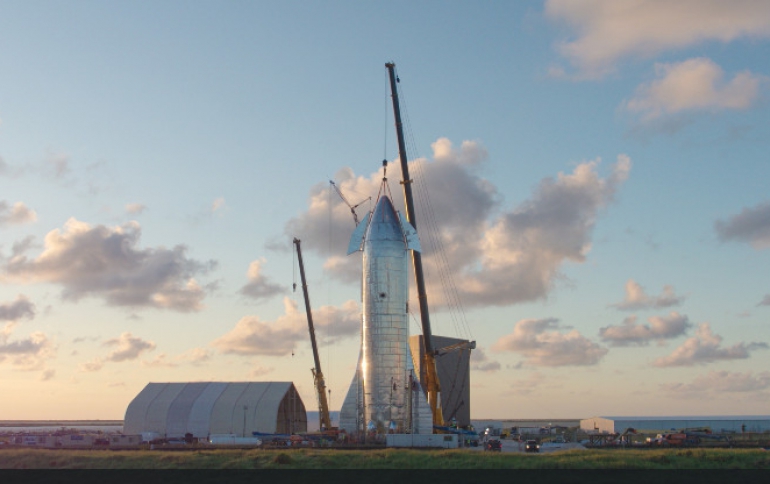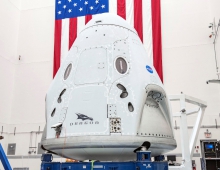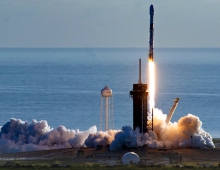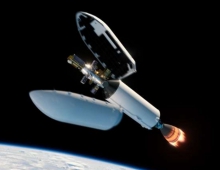
Elon Musk Unveils Ambitious Plan for SpaceX’s Mars ‘Starship’ Rocket
On Saturday, at SpaceX's launch facility in Cameron County, Texas, SpaceX Chief Engineer and CEO Elon Musk provided an update on the design and development of Starship, which they expect will eventually ferry humans to Mars.
SpaceX's Starship and Super Heavy launch vehicle is a fully, rapidly reusable transportation system designed to carry both crew and cargo to Earth orbit, the Moon, Mars, and anywhere else in the solar system.
The goal is to make “space travel like air travel,” Musk said on stage. “We’re really right on the cusp of what’s physically possible.”
Standing before the prototype and an older rocket built early in the company’s history, he pledged that Starship would first take off to an altitude of 65,000 feet and then land, “in about one to two months.”
“This is going to sound totally nuts,” he said later, “but I think we want to try to reach orbit in less than 6 months,” adding that this timeline relied on continued improvements in manufacturing the rockets.
SpaceX currently flies its workhorse Falcon 9 and more powerful Falcon Heavy rockets for customers that include NASA, commercial satellite operators and the U.S. military. NASA has contracted with Boeing and SpaceX to ferry American astronauts to the International Space Station through what’s known as the Commercial Crew Program, but the timeline for the program has repeatedly slipped, and it appears unlikely that either company will fly the first astronauts this year.
Falcon Heavy is essentially a Falcon 9 with two additional Falcon 9 boosters attached to the side. The present-day Falcons are too small for sending people to Mars.
The first version of the spaceship was gargantuan, with a diameter of nearly 40 feet, and the capacity to take 100 people to Mars. A year later, the rocket had been scaled down by one-quarter, to a diameter of 30 feet. The second stage was sleek-looking spacecraft that would return to Earth in one piece, and land vertically.
Starship with the Super Heavy booster is essentially a rocket as powerful as a Saturn 5, which took NASA’s Apollo astronauts to the moon 50 years ago, but it’s fully reusable. For Apollo, everything but the small capsule on top, where the astronauts sat, was discarded along the way, and even the capsule could only be used once.
SpaceX’s prototype resembles something from an old sci-fi movie of the 1950s. In part, that is because in its rush to get the prototypes to the launchpad, SpaceX has not bothered with such aesthetic niceties as paint. Musk originally had planned to use high-tech carbon fiber, but switched to stainless steel. Steel is heavier than carbon fiber and aluminum, another common material used for rockets, but it is also cheaper — about 2 percent of the cost of carbon fiber, Musk said — and has a higher melting temperature that can more easily withstand the heat of re-entry into Earth’s atmosphere.
In August, SpaceX tested a simple prototype that it called Starhopper, with a single engine, which Mr. Musk earlier compared to a flying water tower. It lifted to an altitude of 500 feet, flew sideways and then set down at a different spot. The flight lasted 57 seconds. A shorter July flight went 65 feet in the air.
Musk provided updated schedules for the next phase of test launches, which will start with suborbital flights before heading to orbit. While SpaceX officials have said in the past that a cargo version of Starship could start launching satellites as early as 2021, Musk said that he could even imagine a mission to space with a crew aboard next year.
During a question and answer session with space journalists, Musk responded to NASA Administrator Jim Bridenstine’s Friday tweet that said “Commercial Crew is years behind schedule.” Bridenstine also said the agency expects the same level of enthusiasm seen for SpaceX as on “the investments of the American taxpayer.”
“From a SpaceX resource standpoint, our resources are overwhelmingly on Falcon and Dragon,” Musk said. “Let’s be clear, it was really quite a small percentage of SpaceX that did Starship.”
SpaceX is funding the Starship project with its own money. Some of that comes from positive cash flow from satellite launches. The company has also raised nearly $1 billion from private investors in recent months, and it has also received an undisclosed payment from Japanese Billionaire Yusaku Maezawa as the first customer for a mission to lunar orbit and back.





















